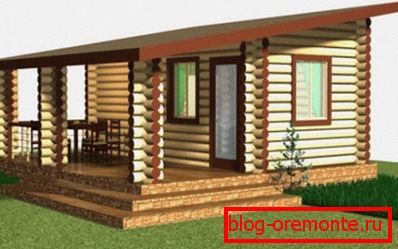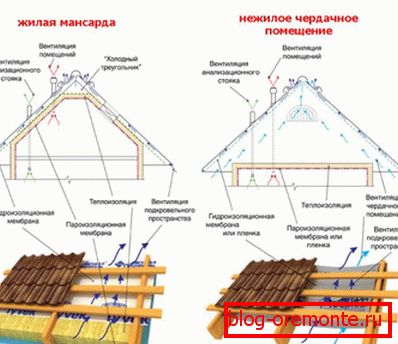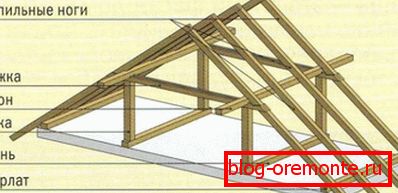How to install rafters on the roof of the bath - video and
Everyone has long known the hot love of Russians for a fast ride, but our countrymen call baths no less warm feelings. High temperatures, high humidity and medicinal steam strengthen the health and immunity of those who have a good habit of steaming regularly. For a device of a truly warm bath, it is usual to use a log or timber log cabin of hard wood, which retains heat for a long time and has healing properties due to the high content of phytoncides. Experienced craftsmen noted that more than 80% of heat loss in the bath occurs through the roof, so it is very important to properly make and install rafters. In this article we will talk about the features of the device of the truss frame of the bath roof, which must be considered during construction.
Roof form
In the role of the bath usually serves a small log house from a log or a bar. As a material for construction, it is recommended to use pine, cedar or larch wood, which has healing properties and high moisture resistance. Since the roof surface has a fairly large area, a lot of heat goes through it. But if you make the right choice of rafters design, then the heat will be stored inside the heated room. The most popular types of roofs that block a log house are considered:
- Sawbone. In fact, the skeleton of the single-pitch roof consists only of the mauerlat and the rafters, which form the plane of its only slope. The recommended slope of this type of roof for Central Russia is 10-25 degrees. The main advantages of a shed roof - simple, quick installation and saving materials. The disadvantage of this option is the impossibility of equipping a normal attic room.


- Dvukhskatnuyu. The gable roof consists of 2 planes at an angle to the base of the roof and forming a recognizable shape. Rafters and puffs form triangular trusses that are resistant to all external influences. If you make a slope in the range of 45-50 degrees, then the snow, melt and rain water will independently slide off the surface of the slope. But the construction of such a structure requires 1.5 times more wood for the manufacture of rafters and 2 times more roofing material.


Note! A log house of undried log or timber gives a significant shrinkage after the wood has dried. Therefore, you must first put the bath box, wait a year for it to take final dimensions, and then just install the rafters and lay the roofing material.
Type of construction
It is important for the construction of the bath that the heat inside it is long preserved. Therefore, most often a small size of the frame is taken, because a small area is easier to heat up by spending less fuel. In addition, you should perform the insulation of the room, due to which the heat loss will be reduced. Depending on the placement of the insulation, there are 2 types of the bath roof:
- Cold Cold roof is a construction in which it is warmed not the surface of the slopes, but the floor of the attic. The attic of the bath is not heated in this case, therefore only storage of bath accessories can be used. For insulating the attic floor, a filling insulating material is used, which perfectly retains heat inside the room heated by the furnace.
- Warm A warm roof is a design that provides for the insulation of ramps between rafters. To make a warm roof harder and more expensive than a shed, but it allows you to equip a comfortable resting place in the roofing space. Mineral insulation in the form of mats or slabs is laid in the inter-roof space of the roof.

Experienced masters and connoisseurs of baths believe that it is better to make a cold roof for this structure, since it is this design that allows you to save more heat inside the room. Such a solution ensures that the bath will warm up faster and cool longer.
Laying the power plate
The roof structure is heavy enough, so the installation of rafters is not performed directly on the bearing walls. In order to evenly distribute the load and prevent deformation of the supports on the upper belt of the box, the power plate is laid. Mauerlat is a durable, flat bar with a section of 100x100 mm or 150x150 mm, mounted on a log house to mitigate pressure on the walls of the rafters of the roof. The installation process of this element of the truss frame of the bath is as follows:
- First, the support bar is cut into pieces of the required length. The length of the mauerlat corresponds to the length of the bath, and the number to the number of roof slopes.
- Then the mauerlat is impregnated with deep penetration antiseptic preparations. The treatment is carried out in duplicate to protect the tree from fungus, mold and rot.
- Mauerlat is fixed on the top row of supporting walls with metal studs or anchor bolts. Moreover, the locations of attachment points are calculated so that they are located between the rafters.
- After installing the master beam, you can proceed to the assembly of the roof truss frame.


Note that if a log house acts as a bath, then it will be correct to use upper rims, reinforced with metal brackets, as a power plate. However, if the construction of the roof is complicated or heavy, then this element of the frame is indispensable.
Frame design
The basis of the roof structure is the roof frame, which bears the weight of the roofing coating, evenly distributes the load between the bearing walls and the foundation, and is also used to fix the waterproofing material. It is made of wood and consists of the following elements:
- Mauerlat This is a kind of support bar, which distributes the weight and softens the pressure of the rafters on the supporting walls of the bath. It is made of square pine timber, on which the rafter legs are fixed.
- Racks. Racks are called vertical supporting frame elements that support the ridge girder or the central part of the truss foot. This element is used only in naslon rafter systems.
- Rafters. Rafter legs are made of planks with a section of 50x150 mm or 100x150 mm, with one end they are installed with an edge on the mauerlat, and with the other they rest against the second leg of a pair or ridge girder.
- The struts. The struts are called supporting frame elements, located at an angle to the rafter legs and prevent them from bending under their own weight.
- Tightening. The horizontal elements in pairs between the truss legs, compensate for the tearing load acting on the supporting walls.
Important! Since the bath is considered a structure with a high risk of fire, it is necessary to make the wooden truss frame resistant to fire. To do this, all parts of the structure are treated with fire retardant.

Assembly technology
If an internal load-bearing wall is planned for the indoor bath project, then it is better to make an inclined truss system consisting of a mauerlat, vertical posts, a ridge girder and a stop. If only external walls are carrying, then it is possible to install only a more complex hanging system. In general, the installation of rafters for the roof of the bath is performed as follows:
- First, on the upper belt bearing walls stack support beam, called Mauerlat, and the ground. Fix it with long metal studs or anchor bolts.
- Then set the rack on the ground. So that they are kept upright during installation, they are temporarily reinforced with struts.
- On the rack stack ridge girder. The correctness of installation podkonykovogo timber checked with the help of construction level.
- Then install the rafters with a step of 60-120 cm, so that it would be convenient to mount the insulation. Fix rafters m using nails, staples, metal plates or sliders.
Experienced craftsmen note that roof trusses for a bathing roof can be assembled on the ground, and then lifted up and installed on the mauerlat as a ready-made form.
